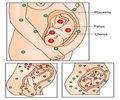Researchers from the University of Pennsylvania School of Medicine have suggested a new method that would help in managing risks in pregnancy, with healthier newborns and better birth
A new method that will help pregnant women manage their condition better and improve outcomes for their babies has been suggested by researchers from the University of Pennsylvania School of Medicine.
The alternative method known as Active Management of Risk in Pregnancy at Term, or AMOR-IPAT, for short uses "risk-based preventative labour induction to ensure that each pregnant woman enters labour at a gestational age that maximizes her chance for vaginal delivery," said lead researcher, Dr James M. Nicholson, Assistant Professor of Family Medicine and Community Health at Penn."Over the past decade, the rates of cesarean delivery have climbed above 30 pct.
"Cesarean delivery, when compared with vaginal delivery, is associated with higher rates of postpartum hemorrhage, major postpartum infection and hospital readmission," he added.
The researchers examined 270 women in between 32 and 371/2 weeks into their pregnancy.
Women who remained undelivered at 37 weeks 4 days of gestation were randomised to either AMOR-IPAT or usual care.
The risk factors for the AMOR-IPAT exposed group were identified and categorized as either interfering with placental growth or accelerating fetal growth.
Advertisement
If a woman in the exposed group did not experience spontaneous labour as she approached the end of this time frame, preventative labour induction was scheduled.
Advertisement
The study showed that AMOR-IPAT approach to obstetric risk lead to healthier babies and better birth outcomes for mothers. In addition, the results challenge the current belief that a greater use of labour induction necessarily leads to higher rates of cesarean delivery.
However, researchers are conducting further studies to explore the potential benefits of the AMOR-IPAT method of care.
Source-ANI
RAS/L











